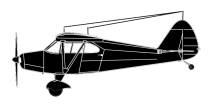
ASN Wikibase Occurrence # 178908
This information is added by users of ASN. Neither ASN nor the Flight Safety Foundation are responsible for the completeness or correctness of this information.
If you feel this information is incomplete or incorrect, you can submit corrected information.
| Date: | Wednesday 23 June 2004 |
| Time: | 09:45 |
| Type: |  Piper PA-20 |
| Owner/operator: | Private |
| Registration: | N699DS |
| MSN: | 20-951 |
| Year of manufacture: | 1953 |
| Engine model: | Lycoming O-320 |
| Fatalities: | Fatalities: 0 / Occupants: 2 |
| Aircraft damage: | Substantial |
| Category: | Accident |
| Location: | Deer Park Airport, Deer Park, Washington -
 United States of America United States of America
|
| Phase: | Landing |
| Nature: | Training |
| Departure airport: | Deer Park, WA (DEW) |
| Deer Park, WA (DEW) | |
| Investigating agency: | NTSB |
| Confidence Rating: |
The pilot/owner had previously received a tail wheel endorsement, but had not utilized it for a number of years. He was therefore working with an instructor to regain his proficiency, but the flight instructor chose to fly in the left seat because the airplane only had brakes on that side, and it had been awhile since he had instructed in a tail wheel aircraft. On the second touch-and-go of the day, the owner made an approach with the intent to do a three-point landing, but inadvertently allowed the airplane's main wheels to contact the ground first, resulting in a bounce. The airplane then touched down in a three-point attitude and began to swerve to the left. The owner applied right rudder, but could not stop the turn. Seeing that the owner was having difficulty, the flight instructor took control of the airplane and attempted to correct the situation by applying "full" right rudder, right brake, and left aileron. The instructor did not take corrective action in time to arrest the left turn, and subsequently, the right main gear collapsed, and the airplane came to rest on the runway. It was ultimately determined that although the aircraft was responding correctly to pilot inputs, a realignment/warping of its fuselage due to a number of previous repairs caused it to be very sensitive to any rudder inputs. Although the aircraft was responding correctly to the pilot's inputs, its degree of sensitivity made it difficult for the owner to control from the right seat, and required quicker than normal remedial action by the flight instructor.
Probable Cause: The flight instructor's delayed remedial action. Factors include the owner/pilot's failure to maintain directional control during the landing roll, and a warped/realigned fuselage that contributed to the sensitivity of the aircraft's response to pilot rudder inputs.
Accident investigation:
 |
|
Sources:
NTSB: https://www.ntsb.gov/_layouts/ntsb.aviation/brief.aspx?ev_id=20040702X00901&key=1
Location
Revision history:
| Date/time | Contributor | Updates |
|---|---|---|
| 22-Aug-2015 17:51 | Noro | Added |
| 21-Dec-2016 19:30 | ASN Update Bot | Updated [Time, Damage, Category, Investigating agency] |
| 07-Dec-2017 18:04 | ASN Update Bot | Updated [Other fatalities, Nature, Departure airport, Destination airport, Source, Narrative] |
Corrections or additions? ... Edit this accident description
The Aviation Safety Network is an exclusive service provided by:


 ©2024 Flight Safety Foundation
©2024 Flight Safety Foundation